育才分流英语语法词法辅导
- 格式:doc
- 大小:41.50 KB
- 文档页数:14
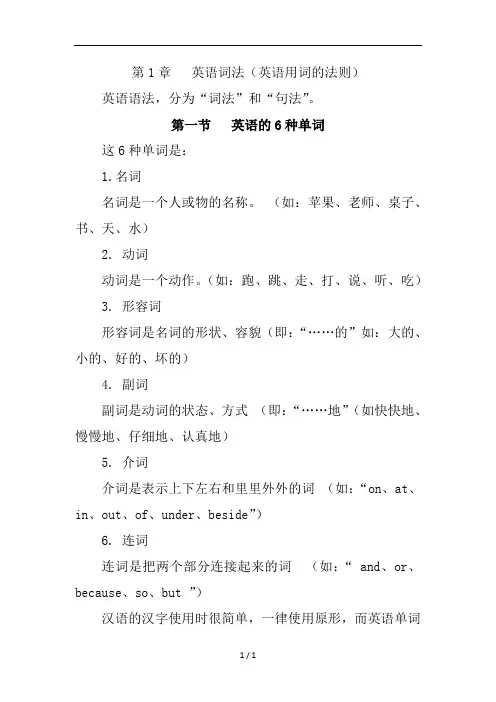
第1章英语词法(英语用词的法则)英语语法,分为“词法”和“句法”。
第一节英语的6种单词这6种单词是:1.名词名词是一个人或物的名称。
(如:苹果、老师、桌子、书、天、水)2. 动词动词是一个动作。
(如:跑、跳、走、打、说、听、吃)3. 形容词形容词是名词的形状、容貌(即:“……的”如:大的、小的、好的、坏的)4. 副词副词是动词的状态、方式(即:“……地”(如快快地、慢慢地、仔细地、认真地)5. 介词介词是表示上下左右和里里外外的词(如:“on、at、in、out、of、under、beside”)6. 连词连词是把两个部分连接起来的词(如:“ and、or、because、so、but ”)汉语的汉字使用时很简单,一律使用原形,而英语单词在使用时,要发生各种各样的变化(比如名词要分单数、复数;形容词、副词要分原级、比较级、最高级;动词要分原形式、三单式、过去式、V-ing式、V-ed式5种书写形式),我们把英语用词的这些变化统称为“词态”变化。
下面就分别讲述以上英语6种词的词态变化。
第二节英语名词的使用规则什么叫名词呢?很简单,就是一个人、一件东西、一件事的名字。
名词是英语单词中数量最大的单词,名词占全部英语单词的80%以上。
英语名词细分为通用名词、专有名词、代词、数词。
通用名词:就是大家谁都可以用的名词。
如:book(书) , table(桌子) , sky(天) , man(人) , student(学生), picture (图画), house(房子) , teacher(老师) , water(水) , school(学校) ,专有名词:就是一个人或物或地方专门拥有的名字(如人名、地名、书名、时间名、机构名等),大家不能随便用。
如:China(中国),America (美国), Canada (加拿大) , New York(纽约), John(约翰), Bush(布什) Monday(星期一) , Sunday (星期日)等等。
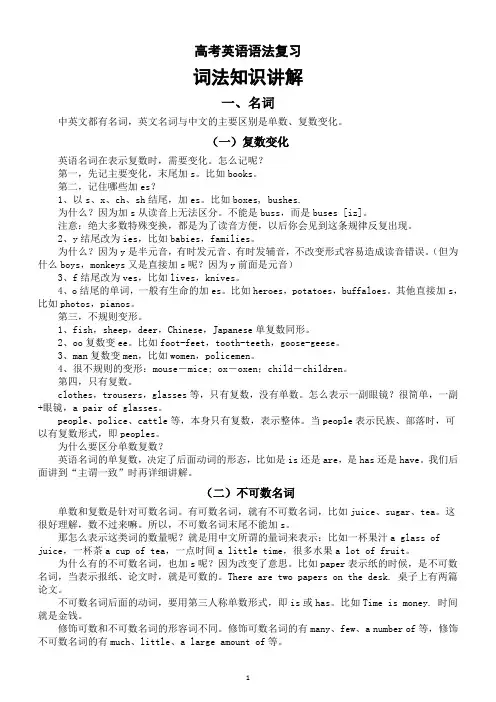
高考英语语法复习词法知识讲解一、名词中英文都有名词,英文名词与中文的主要区别是单数、复数变化。
(一)复数变化英语名词在表示复数时,需要变化。
怎么记呢?第一,先记主要变化,末尾加s。
比如books。
第二,记住哪些加es?1、以s、x、ch、sh结尾,加es。
比如boxes, bushes.为什么?因为加s从读音上无法区分。
不能是buss,而是buses [iz]。
注意:绝大多数特殊变换,都是为了读音方便,以后你会见到这条规律反复出现。
2、y结尾改为ies,比如babies,families。
为什么?因为y是半元音,有时发元音、有时发辅音,不改变形式容易造成读音错误。
(但为什么boys,monkeys又是直接加s呢?因为y前面是元音)3、f结尾改为ves,比如lives,knives。
4、o结尾的单词,一般有生命的加es。
比如heroes,potatoes,buffaloes。
其他直接加s,比如photos,pianos。
第三,不规则变形。
1、fish,sheep,deer,Chinese,Japanese单复数同形。
2、oo复数变ee。
比如foot-feet,tooth-teeth,goose-geese。
3、man复数变men,比如women,policemen。
4、很不规则的变形:mouse-mice; ox-oxen;child-children。
第四,只有复数。
clothes,trousers,glasses等,只有复数,没有单数。
怎么表示一副眼镜?很简单,一副+眼镜,a pair of glasses。
people、police、cattle等,本身只有复数,表示整体。
当people表示民族、部落时,可以有复数形式,即peoples。
为什么要区分单数复数?英语名词的单复数,决定了后面动词的形态,比如是is还是are,是has还是have。
我们后面讲到“主谓一致”时再详细讲解。
(二)不可数名词单数和复数是针对可数名词。
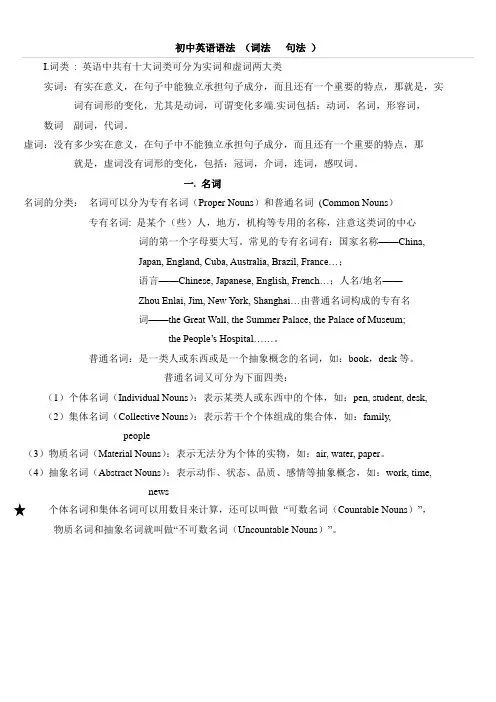
初中英语语法(词法句法)I.词类: 英语中共有十大词类可分为实词和虚词两大类实词:有实在意义,在句子中能独立承担句子成分,而且还有一个重要的特点,那就是,实词有词形的变化,尤其是动词,可谓变化多端.实词包括:动词,名词,形容词,数词副词,代词。
虚词:没有多少实在意义,在句子中不能独立承担句子成分,而且还有一个重要的特点,那就是,虚词没有词形的变化,包括:冠词,介词,连词,感叹词。
一. 名词名词的分类:名词可以分为专有名词(Proper Nouns)和普通名词(Common Nouns)专有名词: 是某个(些)人,地方,机构等专用的名称,注意这类词的中心词的第一个字母要大写。
常见的专有名词有:国家名称——China,Japan, England, Cuba, Australia, Brazil, France…;语言——Chinese, J apanese, English, French…;人名/地名——Zhou Enlai, Jim, New York, Shanghai…由普通名词构成的专有名词——the Great Wall, the Summer Palace, the Palace of Museum;the People’s Hospital……。
普通名词:是一类人或东西或是一个抽象概念的名词,如:book,desk等。
普通名词又可分为下面四类:(1)个体名词(Individual Nouns):表示某类人或东西中的个体,如:pen, student, desk, (2)集体名词(Collective Nouns):表示若干个个体组成的集合体,如:family,people(3)物质名词(Material Nouns):表示无法分为个体的实物,如:air, water, paper。
(4)抽象名词(Abstract Nouns):表示动作、状态、品质、感情等抽象概念,如:work, time,news个体名词和集体名词可以用数目来计算,还可以叫做“可数名词(Countable Nouns)”,物质名词和抽象名词就叫做“不可数名词(Uncountable Nouns)”。
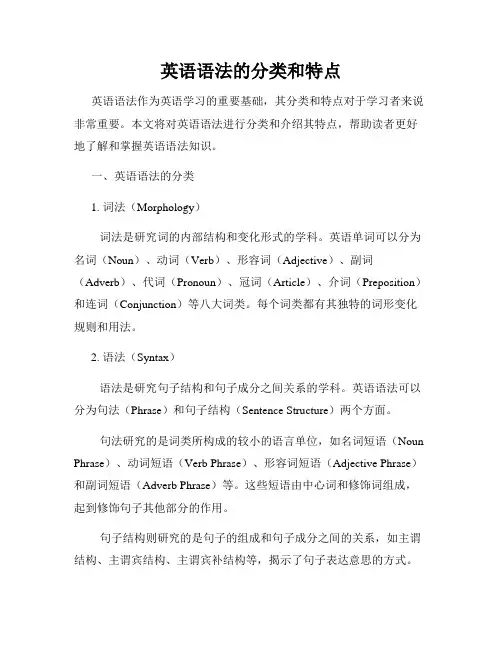
英语语法的分类和特点英语语法作为英语学习的重要基础,其分类和特点对于学习者来说非常重要。
本文将对英语语法进行分类和介绍其特点,帮助读者更好地了解和掌握英语语法知识。
一、英语语法的分类1. 词法(Morphology)词法是研究词的内部结构和变化形式的学科。
英语单词可以分为名词(Noun)、动词(Verb)、形容词(Adjective)、副词(Adverb)、代词(Pronoun)、冠词(Article)、介词(Preposition)和连词(Conjunction)等八大词类。
每个词类都有其独特的词形变化规则和用法。
2. 语法(Syntax)语法是研究句子结构和句子成分之间关系的学科。
英语语法可以分为句法(Phrase)和句子结构(Sentence Structure)两个方面。
句法研究的是词类所构成的较小的语言单位,如名词短语(Noun Phrase)、动词短语(Verb Phrase)、形容词短语(Adjective Phrase)和副词短语(Adverb Phrase)等。
这些短语由中心词和修饰词组成,起到修饰句子其他部分的作用。
句子结构则研究的是句子的组成和句子成分之间的关系,如主谓结构、主谓宾结构、主谓宾补结构等,揭示了句子表达意思的方式。
二、英语语法的特点1. 语序(Word Order)英语是一种固定语序的语言,通常采用主语-谓语-宾语(SVO)的语序。
这种语序使得英语句子的表达更加清晰简洁。
2. 时态(Tense)英语中的时态可以表达动作的发生时间和状态的变化等。
常见的时态有一般现在时、一般过去时、一般将来时等。
时态的正确使用有助于准确表达所要表达的时间概念。
3. 语态(Voice)英语中的语态共有两种:主动语态(Active Voice)和被动语态(Passive Voice)。
主动语态表示主语是动作的执行者,而被动语态则表示主语是动作的承受者。
4. 语气(Mood)英语中的语气用于表示说话者对所述事实的态度。
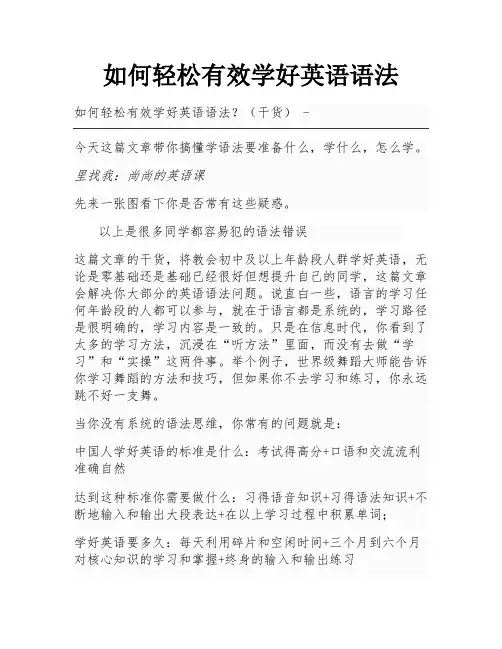
如何轻松有效学好英语语法今天这篇文章带你搞懂学语法要准备什么,学什么,怎么学。
里找我:尚尚的英语课先来一张图看下你是否常有这些疑惑。
以上是很多同学都容易犯的语法错误这篇文章的干货,将教会初中及以上年龄段人群学好英语,无论是零基础还是基础已经很好但想提升自己的同学,这篇文章会解决你大部分的英语语法问题。
说直白一些,语言的学习任何年龄段的人都可以参与,就在于语言都是系统的,学习路径是很明确的,学习内容是一致的。
只是在信息时代,你看到了太多的学习方法,沉浸在“听方法”里面,而没有去做“学习”和“实操”这两件事。
举个例子,世界级舞蹈大师能告诉你学习舞蹈的方法和技巧,但如果你不去学习和练习,你永远跳不好一支舞。
当你没有系统的语法思维,你常有的问题就是:中国人学好英语的标准是什么:考试得高分+口语和交流流利准确自然达到这种标准你需要做什么:习得语音知识+习得语法知识+不断地输入和输出大段表达+在以上学习过程中积累单词;学好英语要多久:每天利用碎片和空闲时间+三个月到六个月对核心知识的学习和掌握+终身的输入和输出练习学英语的路径:听课+练功所以什么中考英语高考英语雅思英语托福英语,都要基于英语的基础知识,所谓各种类型的英语,基础知识掌握好了,针对性准备一下特定考试就完全可以了,这也就是为什么英语学得好的人,什么考试都能够拿高分,什么场景都能流利对话。
基本上没有哪个学生能自己看完一本语法书关于语音知识的重要性和学习干货,请参考之前的文章:一篇文章掌握最全音标学习法(干货) - 尚尚的英语课的文章 -今天将讨论英语语法的学习方式:1.学语法前要准备什么;2.学什么语法;3.系统语法怎么学?准备好了我们就开始吧:1.学语法前的准备:零基础的同学建议至少积累500个基础单词,差不多是小学英语的水平,因为在音标课程结束后,基本上也能够掌握这么多单词了;有一定英语基础的同学,哪怕知识都忘了,但其实拾起来还是比较快的,至少2000个阅读单词的掌握会很快。
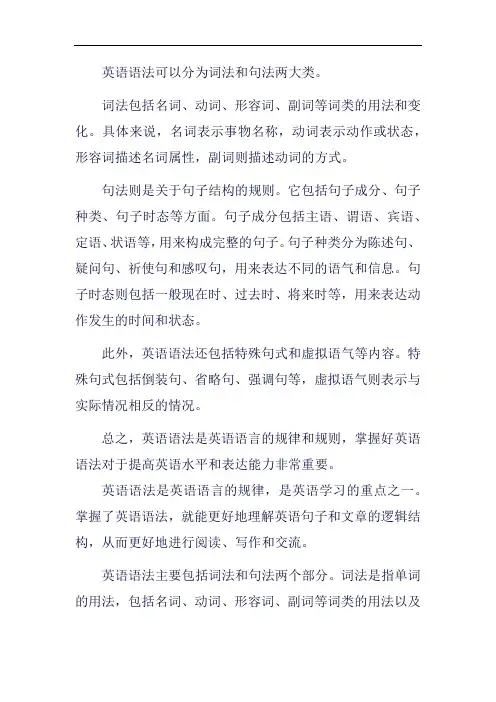
英语语法可以分为词法和句法两大类。
词法包括名词、动词、形容词、副词等词类的用法和变化。
具体来说,名词表示事物名称,动词表示动作或状态,形容词描述名词属性,副词则描述动词的方式。
句法则是关于句子结构的规则。
它包括句子成分、句子种类、句子时态等方面。
句子成分包括主语、谓语、宾语、定语、状语等,用来构成完整的句子。
句子种类分为陈述句、疑问句、祈使句和感叹句,用来表达不同的语气和信息。
句子时态则包括一般现在时、过去时、将来时等,用来表达动作发生的时间和状态。
此外,英语语法还包括特殊句式和虚拟语气等内容。
特殊句式包括倒装句、省略句、强调句等,虚拟语气则表示与实际情况相反的情况。
总之,英语语法是英语语言的规律和规则,掌握好英语语法对于提高英语水平和表达能力非常重要。
英语语法是英语语言的规律,是英语学习的重点之一。
掌握了英语语法,就能更好地理解英语句子和文章的逻辑结构,从而更好地进行阅读、写作和交流。
英语语法主要包括词法和句法两个部分。
词法是指单词的用法,包括名词、动词、形容词、副词等词类的用法以及
词形的变化。
句法是指句子的结构规律,包括句子成分、句子类型、句子时态等。
掌握英语语法需要多读、多写、多听、多说,通过大量的语言实践来培养语感,熟悉英语的语言规则。
同时,也需要认真学习语法规则,通过练习和巩固来提高自己的语法水平。
总之,英语语法是英语学习中必不可少的一部分,只有掌握了正确的语法知识,才能更好地运用英语进行交流和表达。
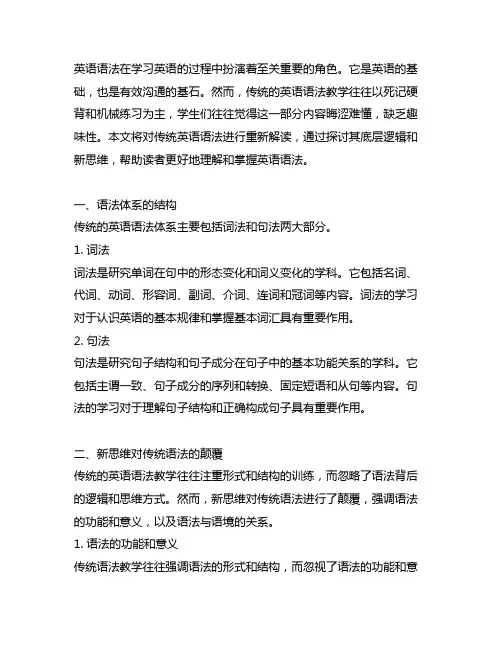
英语语法在学习英语的过程中扮演着至关重要的角色。
它是英语的基础,也是有效沟通的基石。
然而,传统的英语语法教学往往以死记硬背和机械练习为主,学生们往往觉得这一部分内容晦涩难懂,缺乏趣味性。
本文将对传统英语语法进行重新解读,通过探讨其底层逻辑和新思维,帮助读者更好地理解和掌握英语语法。
一、语法体系的结构传统的英语语法体系主要包括词法和句法两大部分。
1. 词法词法是研究单词在句中的形态变化和词义变化的学科。
它包括名词、代词、动词、形容词、副词、介词、连词和冠词等内容。
词法的学习对于认识英语的基本规律和掌握基本词汇具有重要作用。
2. 句法句法是研究句子结构和句子成分在句子中的基本功能关系的学科。
它包括主谓一致、句子成分的序列和转换、固定短语和从句等内容。
句法的学习对于理解句子结构和正确构成句子具有重要作用。
二、新思维对传统语法的颠覆传统的英语语法教学往往注重形式和结构的训练,而忽略了语法背后的逻辑和思维方式。
然而,新思维对传统语法进行了颠覆,强调语法的功能和意义,以及语法与语境的关系。
1. 语法的功能和意义传统语法教学往往强调语法的形式和结构,而忽视了语法的功能和意义。
新思维强调语法作为交际的工具,强调语法在交际中的作用和意义,使学生能够更好地理解和运用语法。
2. 语法与语境的关系传统语法教学往往把语法脱离语境进行训练,忽略了语法与语境的密切关系。
新思维强调语法与语境的关系,强调语法在不同语境下的变化和运用,使学生能够更好地理解和运用语法。
三、语法底层逻辑的全解密语法底层逻辑是语法规则背后的思维方式和逻辑推理。
了解语法底层逻辑有助于学生深入理解语法规则和准确运用语法。
1. 语法底层逻辑的认知语法底层逻辑主要包括逻辑思维、归纳推理和演绎推理等认知方式。
了解这些认知方式有助于学生深入理解语法规则和准确运用语法。
2. 语法底层逻辑的运用语法底层逻辑不仅帮助学生深入理解语法规则,还可以帮助学生准确运用语法。
通过训练学生的逻辑思维和推理能力,可以提高学生的语法水平,使其能够更准确地运用语法。
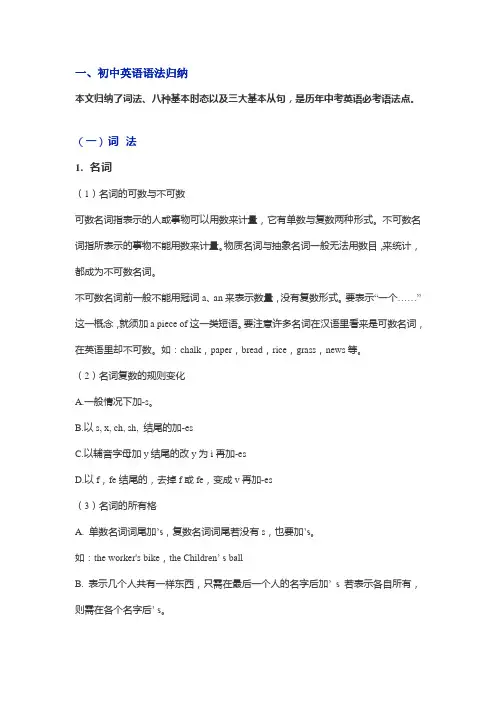
一、初中英语语法归纳本文归纳了词法、八种基本时态以及三大基本从句,是历年中考英语必考语法点。
(一)词法1. 名词(1)名词的可数与不可数可数名词指表示的人或事物可以用数来计量,它有单数与复数两种形式。
不可数名词指所表示的事物不能用数来计量。
物质名词与抽象名词一般无法用数目,来统计,都成为不可数名词。
不可数名词前一般不能用冠词a、an来表示数量,没有复数形式。
要表示“一个……”这一概念,就须加a piece of这一类短语。
要注意许多名词在汉语里看来是可数名词,在英语里却不可数。
如:chalk,paper,bread,rice,grass,news等。
(2)名词复数的规则变化A.一般情况下加-s。
B.以s, x, ch, sh, 结尾的加-esC.以辅音字母加y结尾的改y为i再加-esD.以f,fe结尾的,去掉f或fe,变成v再加-es(3)名词的所有格A. 单数名词词尾加’s,复数名词词尾若没有s,也要加’s。
如:the worker's bike,the Children’ s ballB. 表示几个人共有一样东西,只需在最后一个人的名字后加’ s若表示各自所有,则需在各个名字后’ s。
如:This is Lucy and Licy’ s room.These are Kate's and jack’ s rooms.C. 如果是通过在词尾加—s构成的复数形式的名词,只加’。
如:the students’ books,the girls’ blouses(另外:名词+of+名词名词是有生命的,我们就用’s结构来表示所有关系。
如果名词所表示的事物是无生命的,我们就要用名词+of+名词的结构来表示所有关系。
) 2. 代词人称代词,物主代词,反身代词,指示代词,不定代词(1)人称代词第一人称单数I me my mine myself复数 we us our ours ourselves第二人称单数 you you your yours yourself复数 you you your yours yourselves第三人称单数 he him his his himselfshe her her hers herselfit it its its itself复数 they them their theirs themselves(2)物主代词物主代词的用法:形容词性物主代词后面一定要跟上一个名词;名词性物主代词可作主语、表语、宾语。
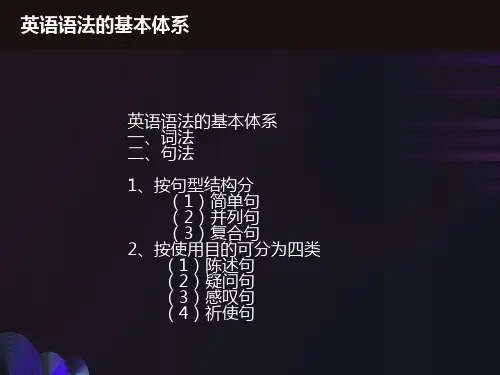

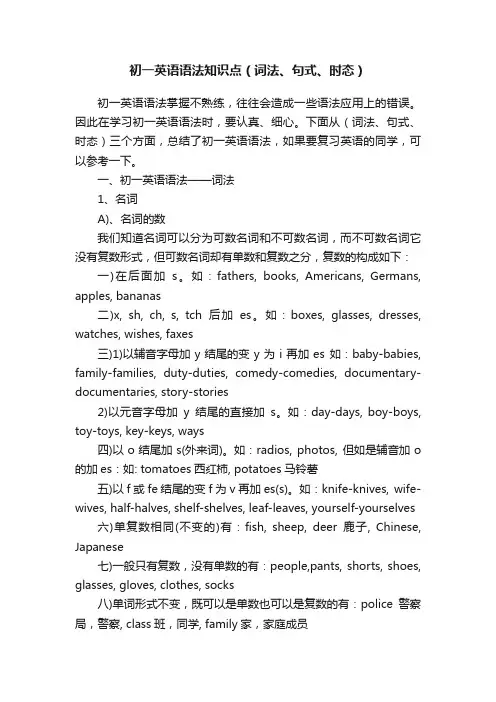
初一英语语法知识点(词法、句式、时态)初一英语语法掌握不熟练,往往会造成一些语法应用上的错误。
因此在学习初一英语语法时,要认真、细心。
下面从(词法、句式、时态)三个方面,总结了初一英语语法,如果要复习英语的同学,可以参考一下。
一、初一英语语法——词法1、名词A)、名词的数我们知道名词可以分为可数名词和不可数名词,而不可数名词它没有复数形式,但可数名词却有单数和复数之分,复数的构成如下:一)在后面加s。
如:fathers, books, Americans, Germans, apples, bananas二)x, sh, ch, s, tch后加es。
如:boxes, glasses, dresses, watches, wishes, faxes三)1)以辅音字母加y结尾的变y为i再加es 如:baby-babies, family-families, duty-duties, comedy-comedies, documentary-documentaries, story-stories2)以元音字母加y结尾的直接加s。
如:day-days, boy-boys, toy-toys, key-keys, ways四)以o结尾加s(外来词)。
如:radios, photos, 但如是辅音加o 的加es:如: tomatoes西红柿, potatoes马铃薯五)以f或fe结尾的变f为v再加es(s)。
如:knife-knives, wife-wives, half-halves, shelf-shelves, leaf-leaves, yourself-yourselves六)单复数相同(不变的)有:fish, sheep, deer鹿子, Chinese, Japanese七)一般只有复数,没有单数的有:people,pants, shorts, shoes, glasses, gloves, clothes, socks八)单词形式不变,既可以是单数也可以是复数的有:police警察局,警察, class班,同学, family家,家庭成员九)合成的复数一般只加主要名词,多数为后一个单词。
初中英语语法(词法句法)有些名词在一种场合下属于这一类,在另一种场合下又属于那一类。
例如有些物质名词也可用作个体名词,意思上有一定变化:glass玻璃-a glass玻璃杯iron铁-an iron熨斗paper纸-a paper报纸,证件wood木头-a wood树林又如一些抽象名词,当意思转变而表示某类个体时,就成了个体名词:youth青春-a youth青年人relation关系-a relation亲属democracy民主-a democracy民主国家authority权威-an authority权威人士power威力,电力-a power大国necessity必要性-a necessity必需品beauty美-a beauty每人,美的东西可数名词的复数规则变化:一、绝大多数的可数名词的复数形式,是在该词末尾加上后辍-s。
读音变化:结尾是清辅音读[s],结尾是浊辅音或元音读[z]。
例:friend→friends; cat→cats;sport→sports; piece→pieces二、凡是以s、z、x、ch、sh结尾的词,在该词末尾加上后辍-es构成复数。
读音变化:统一加读[iz]。
例:bus→buses; quiz→quizzes; fox→foxes; match→matches;flash→flashes box →boxes; watch →watches; actress →actresses;class →classes; coach(长途车)→coaches; dress →dresses;sandwich →sandwiches; toothbrush →toothbr ushes;waitress(女侍者)→waitresses三、以辅音字母+y结尾的名词,将y改变为i,再加-es。
读音变化:加读[z]。
例:candy→candies; fairy→fairies; lady→ladies; story→stories strawberry →strawberries; baby →babies; puppy →puppies; library →libraries; dictionary →dictionaries; cherry →cherries; activity →activities四、以-o结尾的名词,有生命的加es,无生命的加s, 读音变化:加s读[z],加es 读/iz/。
英语词法
英语词法是指英语中词汇的构成、变化和用法规则。
它包括以下几个方面:
1. 词汇分类:名词、动词、形容词、副词、代词、介词、连词、冠词等。
2. 词形变化:名词的复数形式、动词的时态、语态、语气等,形容词和副词的比较级和最高级。
3. 词汇搭配:习惯用语、固定搭配、短语等。
4. 派生法:通过在词根上添加前缀或后缀构成新词。
5. 合成法:由两个或多个单词组合成一个新词。
6. 转换法:一种词性转换成另一种词性,如动词转换为名词,形容词转换为副词等。
7. 缩略法:将较长的单词或短语缩短,如 "TV" 代表 "television"。
掌握英语词法对于学习者来说非常重要,它可以帮助学习者正确使用词汇,理解句子结构,提高英语表达的准确性。
同时,学习者还需要通过大量的阅读和练习来巩固和运用所学的词法知识。
以上只是对英语词法的简单介绍,如果你想深入学习,建议你查阅相关的英语语法书籍或资料,以获取更详细和全面的信息。
英语语法学英语语法学是研究英语语言规则和结构的学科,它包括词法、句法、语义学、语用学、语态学、时态和语态、名词性从句、关系从句、虚拟语气以及强调句型等方面。
1.词法(Morphology)词法是研究单词的构成和变化的规则。
英语单词通常由词根、前缀、后缀等构成,通过添加不同的前缀和后缀,单词的含义和用法会发生变化。
2.句法(Syntax)句法是研究句子结构的规则。
在英语中,句子通常由主语和谓语构成,主语通常在谓语之前,宾语和补语通常在谓语之后。
此外,句子的结构还包括从句、短语、介词短语等。
3.语义学(Semantics)语义学是研究语言意义和理解的规则。
语义学涉及单词和句子的含义、指代、修饰等内容。
通过理解单词和句子的含义,我们可以更好地理解文本的意思。
4.语用学(Pragmatics)语用学是研究语言使用和交流的规则。
语用学涉及语言在社会和文化背景下的使用,包括对话、演讲、写作等。
通过理解语用学,我们可以更好地理解语言在社会和文化背景下的含义和使用。
5.语态学(Voice)与时态和语态(Tense and Voice)语态学是研究动词的形式和变化的规则。
动词的形式包括现在时、过去时、将来时等时态,以及主动语态和被动语态等。
通过理解动词的形式和变化,我们可以更好地理解句子的意思和语气。
6.名词性从句(Noun clauses)、关系从句(Relative clauses)与虚拟语气(Subjunctive)名词性从句是由一个句子作为名词的成分,通常在主句中充当主语、宾语或表语等。
关系从句是用来修饰名词性从句的从句,通常用来提供更多关于名词性从句中提到的名词的信息。
虚拟语气是一种特殊的动词形式,用来表达假设或条件的情况,而不是真实的情况。
7.强调句型(Emphatic structures)强调句型是用来强调句子中某个成分的特殊语法结构。
通过使用强调句型,我们可以突出句子中的某个部分,使其更加明显或重要。
三天搞定英语语法英语语法分为两个部分。
一个部分是词法,即词的构成和词的使用规律。
另一个部分是句法,即句子的组成和句子的使用方法。
英语语法的特点可以用三句话来表示:1、每个词都有词性;2、每句话都有动词(实意动词或系动词);3、每句话都必须符合五个基本句型。
三句话用一句话来说,就是,标出句中每一个单词的词性,找出句中所有动词,并标出其种类和相应的句子成分。
理解,掌握,运用好这句话,按照一:词性;二:动词种类;三:动词相对应的句子成分;四:从句;五:非谓语动词方法就能透彻理解英语语法体系。
词的分类词性的分类:修饰: 形容数冠代词名词(red)(one)(a/the)(my) wood1.名词代替: 代词it 形容词 the red 数词one及物动词 drink,eat 副词修饰实意动词1.实意动词不及物动词 walk①be 是 I am fat2.动词 2.系动词②感官 smell,taste,feel,sound③变化 get become turn3.助动词 will,shall,be,do,have表否定,疑问,时态,语态,强调(I am reading)4.情态动词 can,may,mustadj 修饰名(形容)the man(at the table)介词+名词adv 修饰动3.两靠两不靠(副) stand [at the table]并列连词 and,but,or连词从属连词 because,when,if注意:词的兼类有不少单词不仅仅属于一个词类,辨别一个单词属于何种词类只能在句子当中进行,脱离了具体的语言环境是很难说明一个单词是属于何种词类的。
试看以下两个例句:(1)He longed to be back home. 他渴望回到家中。
(2)She has long hair. 她有长长的头发。
第一个例句中的long是"渴望",第二个例句中的long是"长"。
如何帮助孩子更好地理解英语语法?指导孩子更好地理解英语语法,需要循序渐进,运用自如。
解释英语语法是孩子完全掌握英语的关键,也是他们进行清晰表达和准确理解的基础。
但是,比较传统的语法教学方法比较乏味枯燥,很难激发孩子的学习兴趣。
因此,家长和老师必须采用更有效的方法,指导孩子理解和掌握英语语法。
一、可以循序渐进,由浅及深:1. 从基础开始:英语语法并非一蹴而就,需要循序渐进地学习。
从最基本的词性和句子结构开始练习,让孩子渐渐地掌握基础知识。
例如,可以用图画、游戏等帮助孩子明白名词、动词、形容词等词性的含义,并从简单的句型开始练习,让孩子明确地掌握主语、谓语、宾语等句子成分。
2. 逐步深入:在孩子掌握基础语法知识后,可以逐步深入讲解更复杂的语法结构,例如时态、语态、虚拟语气等。
教师也可以借用情景对话、故事阅读等,将语法知识融入到真实的语言环境中,指导孩子理解和运用语法规则。
3. 生动化练习,巩固学习:定时进行语法练习是积累学习成果的重要方法。
练习题的设计要具有针对性,并与孩子当前的学习内容相匹配。
当然,还可以鼓励孩子进行各种英语学习活动,例如外语角、英语戏剧等,在实践中应用语法知识。
二、寓教于乐,激发兴趣:1. 利用游戏化教学:游戏可以将枯燥的语法学习变得更加生动有趣。
例如,可以设计“语法拼图”、“语法大接龙”等游戏,让孩子在玩乐中学语法知识。
2. 增强生活实际:将语法学习与生活实际相结合,可以让孩子更容易理解和记忆。
例如,可以在购物场景讲解“可数名词”和“不可数名词”的区别,在实际旅游场景讲解不同时态的运用。
3. 鼓励创造性表达:通过写作、绘画、表演等,鼓励孩子用英语表达自己的想法,并在表达过程中不断运用和巩固语法知识。
三、注重理解,而非死记硬背:1. 解释语法规则:教师要解释清楚语法规则的含义,用通俗易懂的语言进行说明,指导孩子理解语法规则背后的逻辑。
2. 提供例句分析:通过分析大量的例句,让孩子理解语法规则在实际应用中的用法,并能举一反三。
育才分流英语语法词法精品辅导3情态动词、虚拟语气、非谓语动词名词性从句和定语从句情态动词【要点点拨】1.表示请求和允许:can,could,may,might.过去式使语气更委婉,答语应用原形。
---Could Iuse your computer tomorrow morning?---Yes,you can.(否定回答可用:No,I'm afraid not.)2.表示推测:理论可能性can可能性肯定句must,may,might,could疑问句can否定句can't(不可能),may not(可能不)1)can表示理论上的可能性,指某事或情况可能发生,但并不说明实际上真的发生.Children can be very tiring.2)反意问句。
He may know the plan,doesn'the?You must have studied Englishbefore,haven'tyou?You can't have beencaught in the rain last night,wereyou?3.could&be able to在肯定句中could表示过去有"能力"做,was/were able to表示过去有能力而且确实做成了某一件事,相当于managed to do…或succeeded in doing sth.The fire spread through the hotel very quickly but everyone was able to get out.4.may/might as well do sth"还是…好"、"不妨"You might as well tell me the truth.你还是把真相告诉我的好。
5.must和have to 1)must表示的是说话人的主观看法,而have to强调客观需要。
2)否定形式含义不同。
mustn't禁止,不许可,don't have to不必3)must偏要(做令人不快的事)eg.Must you shout so loudly?6.shall和should 1)表示说话人征求对方意见和向对方请示,用于第一、三人称。
When shall my father be able to leave hospital?shall 2)表示说话人给对方的命令、警告、允诺或威胁以及说话人的决心。
You shall go with me(命令)/You shall have the book when Ifinish it.(允诺)He shall be punished(威胁)/Nothing shall stop me from doingit.(决心)1)表示劝告和建议"应该"2)"按道理应当""估计"(=ought to)They should be there by now,I think.3)用于第一人称表示说话人的一种谦逊、客气、委婉的语气。
I should advise you not do that.我倒是劝你别这样做。
Should 4)在条件句中表示"万一",主句不一定用虚拟语气。
Ask Tom to ring me up if you should see him./Should Ibe free tomorrow,I'll come.5)Why/How+should结构表示说话人对某事不能理解,感到意外、惊异等意思,意为"竟然",也用在某些从句中。
It seems so unfair that this should happen to me.这种事竟然发生在我身上真不公平。
7.will和would 1)表示意志和意愿。
will指现在,would指过去。
If you will listen to me,I'll give you some advice.2)表示请求、建议,would比will委婉、客气。
Will(Would)you please pass me the book?3)表示习惯性动作,"总是""惯于",will指现在,would指过去。
Fish will die without water.Every evening,she would sit by the window,deep in thought.4).表示功能,意为"能"或"行"The machine won't work.5)表示预料或猜想。
It would be about ten when he left home.猜想他离开家时大约十点。
8.would&used to 1)表示过去持续的状态和情况用used to;would不与表示状态的动词连用。
There used to be ahospital here./There would be ahospital here.(×)2)would常与often,sometimes,for hours等表示时间的副词(短语)连用。
We would sit in the yard every evening and listened to his story.3)used to强调过去的行为同现在的对比,含有"过去怎样,而现在却不这样了"的含义.eg.He will not spend the money on books as he used to.9.dare和need两者作为情态动词都不用于肯定句,常用于否定句、疑问句和条件从句中。
习惯用语I dare say(可能,或许,我揣测)除外。
实义动词用法同于一般动词。
但在否定句中,dare后的to可省略,即:don't/doesn'tdare(to)do….need作为实义动词时,用在否定句中时,其后的to不能省略。
He dare go there alone.(×)He dares to go there.He dares not go there alone.(×)He dare not go there alone./He doesn't dare(to)go there alone.He stood there without daring lift his head.(×)He stood there without daring to lift his head.10.情态动词+have done,表示过去比较:情态动词+do,表示现在或将来。
cf.needn't have done&didn't need to do…She need not have come yesterday.她昨天本不必要来的。
(但却来了) She didn't need to come yesterday.她昨天不必来。
(实际上也没来) 虚拟语气【要点点拨】一:形式为(should)+v.1.宾语从句中。
一个坚持(insist),两个命令(order,command),三条建议(advise,suggest,propose),四项要求(demand,require,request,ask).还有prefer,advise等词。
注意:1)suggest和insist有例外The smile on his face suggested that he was satisfied with our work.("暗示""表明")The man insisted that he had never stolen the money.2)这类动词的名词形式后的表语从句和同位语从句中也要用(should)+v.形式。
另外,还有plan,idea等词。
2.主语从句中1)It is necessary/important/strange/natural/a pity/a shame/no wonder…that….eg.It is strange that he should have acted towards his parents like that.二:形式为在原本的时态上退一步,即"+过去"1.在条件句中的运用条件从句主句与现在事实相反过去式(be一般用were)would/could/might+v.与过去事实相反had+过去分词would/could/might+have+过去分词与将来事实相反1)过去式2)should+v.3)were to+v.would/could/might+v.(第一人称可用should,以上同)1)"混合虚拟条件句"或"错综时间条件句"主句和从句时间上不一致,从句可以和过去时间相反,主句可以与现在事实相反。
If you had taken my advice just now,you would be better now.2)if省略句。
在条件句中,可省略if,把were,had,should提到句首,变为倒装句式。
Were Iyou,I would seize the chance to go abroad.3)含蓄条件句A)with,without,but for等介词短语代替条件句But for the rain,the crops would have died.(=If it hadn't been for the rain)B)其他手段I was ill that day.Otherwise,I would have taken part in the sports meeting.(副词)He telephoned to inform me of your birthday,orI would have known nothing about it.(连词)I might have given you more help,butI was too busy.(连词)Given more time,we could have done it better.(分词短语)It would be amistakenot to help him.(动词不定式)2.宾语从句中wish,would rather后,但would rather后所跟句子跟现在、将来相反用过去时,跟过去时间相反使用过去完成时。